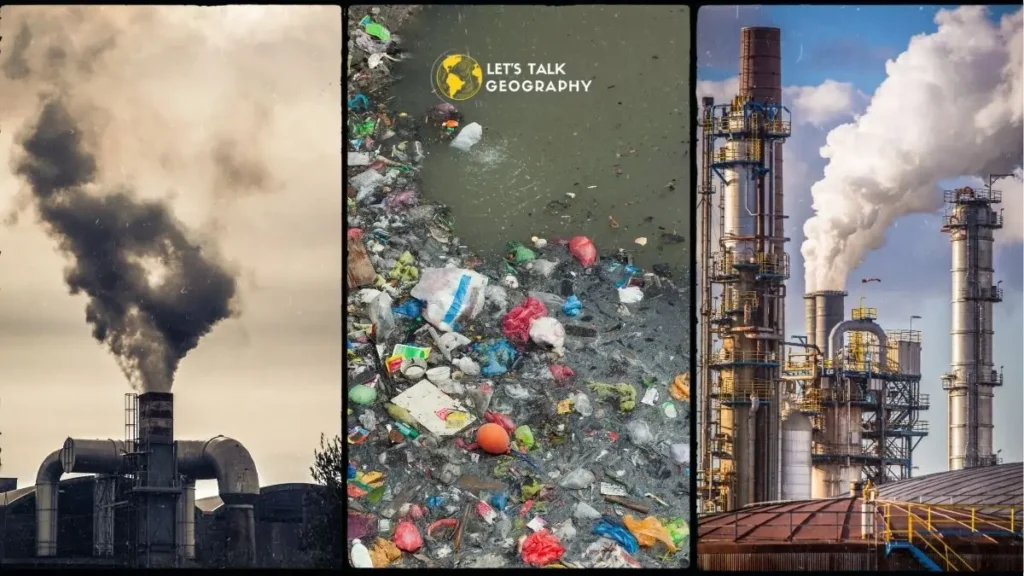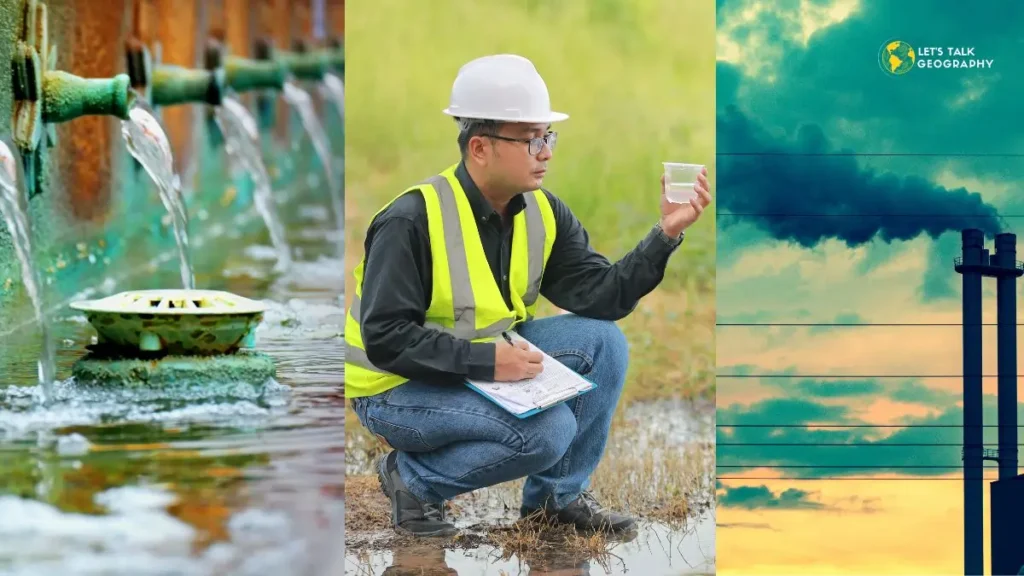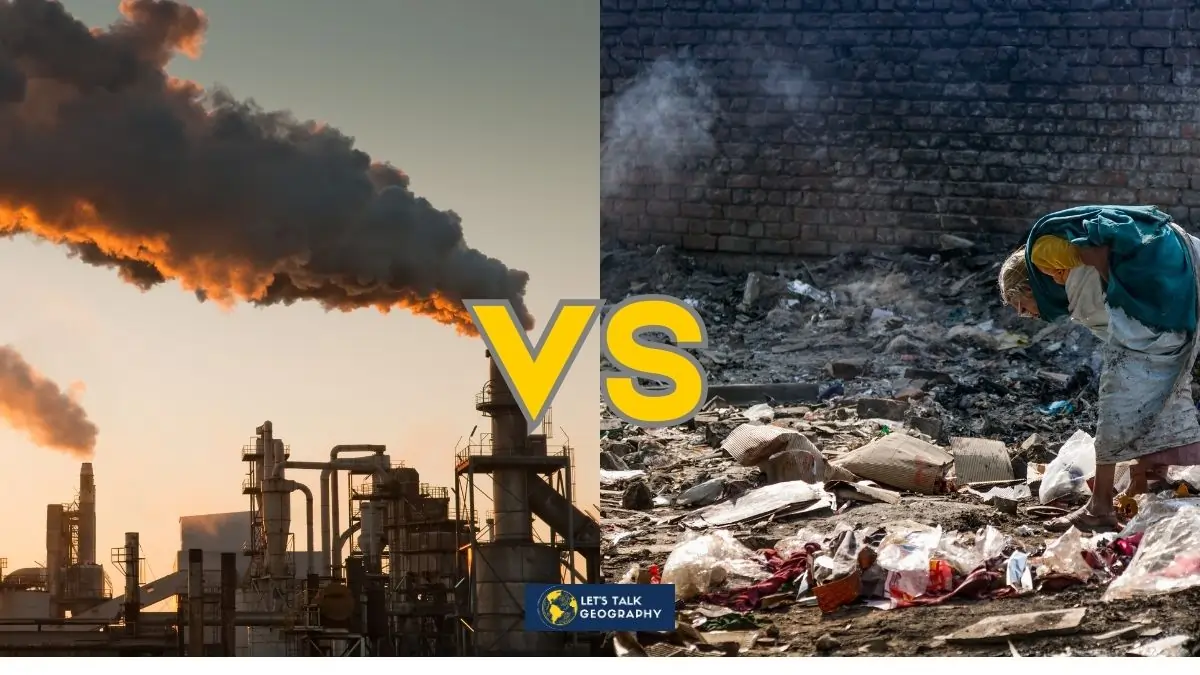Importance of Clean Air
Imagine breathing in air that’s a cocktail of invisible threats, each more harmful than the last. Understanding what we’re inhaling can differentiate health and chronic illness.
Primary and secondary pollutants are crucial in discussing air quality and human health. Primary pollutants are emitted directly from sources like vehicles and factories, while secondary pollutants form in the atmosphere through chemical reactions. Comparing primary and secondary pollutants reveals their distinct characteristics and varying environmental and public health impacts.
This article will delve deep into the dissimilarities between primary and secondary pollutants, analyze their sources and formation processes, and assess which type poses a greater threat to human health and the environment. By understanding the nuances of these pollutants, we can better address air pollution and implement effective control measures.
Read also: Pollution – A Global Issue | 5 Major Effects of Pollution that Damaging Our Planet
Understanding Pollutants
Primary Pollutants
Primary pollutants are the sources that can increase pollution levels in the state in which they have been released at the source; they are considered harmful to animals and human health.
Air pollutants are primary pollutants released directly into the atmosphere. These include carbon monoxide, nitrogen oxide, sulfur dioxide, volatile organic compounds, and aerosols. In urban areas, the primary source of primary pollutants is burning fossil fuel, which is also the main source of microorganisms.

Carbon monoxide is a colorless and odorless gas introduced into the atmosphere through gasoline or fuel burning.
Read also: Air Pollution | How to Measure it and its 7 Severe Effects
Read also: Beyond the Blue: Exploring the 5 Astonishing Layers of the Atmosphere That Protect Our Planet
Secondary Pollutants
Secondary pollutants are pollutants created in the atmosphere. They are not directly radiated from a source. Instead, the pollutants released from these get mixed into the atmosphere, forming new pollutants. Secondary pollutants are becoming a huge concern as they can be formed from different sources. Photochemical smog is created from secondary pollutants like ozone, peroxyl nitrates, and nitric acid.
Common examples of Secondary pollutants include Ozone, sulphuric acid, nitric acid, particulate matter, nitrogen dioxide, and more. These substances are found on the downside of the primary emissions due to the production time. The secondary pollutants may adversely affect human health, including declines in respiratory function and eye irritation, and may also lead to emphysema and other lung problems.
Read also: What is the greatest contributor to air pollution in the United States?
Read also: Why Urbanization Contributes to Pollution- 5 Alarming Facts About It
Air Pollution and Its Consequences
Air pollution refers to any physical, chemical, or biological alterations in the air. It is contaminated by harmful gases, dust, or smoke that adversely affect plants, animals, and humans.
Types and sources of air pollution
There are dual types of air pollution: primary pollution and secondary pollution. Here, the pollutants that directly lead to air pollution are also known as primary pollution. The intermixing forms these pollutants, and the reaction caused is known as secondary pollution.
Burning fossil fuels, agricultural activities, factories and industries, and mining activities are the primary causes of air pollution. Other sources include domestic sources.
Read also: When Fossil Fuel Will Run Out? Can Fossil Fuels be Renewed?
Global and local impacts of Air Pollution
Effects of air pollution include the occurrence of various diseases and respiratory problems. The cases of lung cancer due to pollution. Another includes acid rain, one of the most stressful situations and releases much gas.
Acid Rain
Acid rain, called acid deposition, consists of any precipitation filled with acidic substances, including sulphuric or nitric acid, that falls on the surface from the atmosphere in wet or dry forms. This precipitation can consist of rain, snow, fog, hail, or even dust, which is considered acidic.
Acid rain is introduced when sulfur dioxide and nitrogen oxide are emitted into the atmosphere and are carried by wind and air currents. The SO2 and NOx get mixed with water, oxygen, and other chemicals to form sulphuric and nitric acid. They accumulate with water and other materials and fall on the ground.
Read also: How does Acid Rain affect Climate change?
Eutrophication
Eutrophication is a process in which a water body becomes filled with nutrients that lead to the plentiful growth of simple plant life. The huge growth of algae and plankton indicates this process. It is considered a crucial concern because it leads to a decline in the water quality and depletion of oxygen in the water body.
The main contributor to eutrophication is phosphorus, which is found in fertilizers, insecticides, and pesticides. Phosphorus is present in soil and flows into the soil due to rain, causing eutrophication, which eventually causes suffocation and the death of marine animals.
Ozone Depletion
The hole in the ozone layer is caused by chemicals such as refrigerants, including chlorofluorocarbons, which contain chlorine atoms and emit chlorine into the atmosphere, ruining the ozone. A single chlorine atom can ruin many ozone molecules, leading to receiving huge amounts of radiation from the sun, which may cause sunburn and skin cancers in humans and restrict plant development.
Read also: Ozone Layer: Discover the Vital Atmospheric Layer Protecting Our Planet
Climate Change
Air pollutants, including methane and black carbon, are the most short-lived climatic pollutants (SLCPs) that cause changes in climate and health problems. Even though SLCPs stay in the atmosphere for a little time, their global warming is often much more than carbon dioxide’s.
Black carbon, part of fine particulate matter, primarily contributes to global warming next to CO2. Black carbon warms the earth’s surface by taking in sunlight, thus catalyzing snow and ice melting. Methane, different from SLCP, is a potent greenhouse gas 84 times more powerful than CO2 and a contributor to air pollutant ozone. Ozone and black carbon harm the earth’s water and decline agriculture yield, thus melting snow and ice.
Read also: Climate Change | 7 Alarming Effects and the Major Causes Behind
Read also: How Does Pollution Affect Animals? – 5 Tragic Effects
Comparison of Primary and Secondary Pollutants
- Primary pollutants are formed directly from the sources, whereas secondary pollutants form after the components of primary air pollutants and atmospheric elements exchange.
- Primary pollutants have a direct impact on the atmosphere and organisms and an indirect effect on the formation of secondary pollutants. In contrast, secondary pollutants are affected when photochemical agents are mixed in their formation.
- Primary pollutants could be handled by taking into consideration the activities of humans, whereas secondary pollutants are daunting to control
- Primary components include aerosols, hydrosols, sulfur dioxide, nitrogen dioxide, and carbon monoxide, whereas secondary pollutants include acid, photochemical smog, and peroxyacetyl.
Measures to Control Pollution Sources
Point Source Pollution
They are implementing strict regulations and permitting discharges from factories, sewage treatment plants, and other facilities. Other advanced technologies for sewage treatment include filtration, sedimentation, and biological therapy to decrease the volume of pollution before discharge.

Regular monitoring and surveys need to be regulated. They are implementing waste management practices for cleaner production methods, promoting best practices, and raising awareness for pollution prevention.
Non-point Source Pollution
They are adding best management practices such as contour ploughing, crop rotation, and utilization of cover crops to reduce runoffs, as well as utilizing all techniques for optimizing fertilizer, applying pesticides, and decreasing excess runoffs. Implement green infrastructure, including rain gardens, roofs, and permeable soaking and filtering runoffs.
They are making buffer zones and vegetation around water bodies to trap and filter pollutants before they enter waterways. They are raising awareness of the impact of nonpoint sources of pollution and adding to the community to prevent pollution activities. Implement laws and regulations to support the management programs.
Conclusion
In conclusion, comparing primary and secondary pollutants reveals crucial insights into their environmental and human health impacts. Main pollutants, such as carbon monoxide and sulfur dioxide, are directly emitted from sources like vehicles and industrial processes, posing immediate risks. However, secondary pollutants, including ozone and particulate matter, form with the help of complex chemical reactions in the atmosphere, often resulting in more pervasive and long-term harm.
Understanding the distinctions between primary and secondary pollutants is essential for developing effective pollution control strategies. While primary pollutants can be mitigated at their source, addressing secondary pollutants requires comprehensive approaches that consider atmospheric chemistry and broader environmental interactions.
Ultimately, recognizing the complexities of primary and secondary pollutants underscores the need for robust policies and innovative solutions to protect public health and preserve ecological integrity. This holistic perspective is vital in our ongoing efforts to combat air pollution and its far-reaching consequences.
Call to action for better air quality
Understanding the differences between primary and secondary pollutants is important for making informed decisions about environmental protection. Subscribe to our blog for more insights on pollution and its impacts. Join the chats in the comments and share your judgment on which type of pollutant you find more harmful and why. Let’s work together for a cleaner, healthier future!
FAQs
1. What are primary pollutants?
Primary pollutants are directly radiated from a source into the atmosphere. They include substances like carbon monoxide (CO) and sulfur dioxide (SO2), nitrogen oxides, particulate matter (PM), and volatile organic compounds (VOCs). They originate from combustion processes, industrial emissions, and vehicle exhaust.
2. What are secondary pollutants?
Secondary pollutants are not emitted directly but are created in the atmosphere through chemical reactions among primary pollutants and other atmospheric components. Examples include ozone (O3), smog, and acid rain. These pollutants often result from complex interactions involving sunlight, water vapor, and chemicals.
3. How do primary and secondary pollutants differ in terms of sources?
Primary pollutants come directly from identifiable sources like factories, vehicles, and natural events (e.g., wildfires, volcanic eruptions). In contrast, secondary pollutants form through atmospheric reactions involving primary pollutants. For example, ground-level ozone forms when NOx and VOCs react in sunlight.
4. Which pollutants are more harmful to human health, primary or secondary?
Both primary and secondary pollutants pose significant health risks, but secondary pollutants can be more harmful due to their widespread impact and persistence. For instance, ground-level ozone and particulate matter from secondary reactions can penetrate the lungs, causing respiratory issues, cardiovascular diseases, and other health problems.
5. What are the environmental impacts of primary and secondary pollutants?
Primary pollutants contribute directly to air pollution and environmental degradation. For example, sulfur dioxide can lead to acid rain, harming ecosystems and structures. Secondary pollutants, like smog and acid rain, have broader and more severe environmental impacts, affecting air quality, water sources, soil, and vegetation.
6. How can the harmful effects of primary and secondary pollutants be mitigated?
Mitigating the harmful effects of these pollutants involves reducing emissions at the source. Strategies for primary pollutants include adopting cleaner technologies, improving fuel quality, and implementing stringent emissions regulations. For secondary pollutants, strategies focus on lowering precursor emissions (e.g., NOx and VOCs) and enhancing atmospheric monitoring and pollution control measures to prevent their formation.
References
- Primary pollutants. (2022, March 31). Unacademy. https://unacademy.com/content/neet-ug/study-material/biology/primary-pollutants/
- Secondary pollutant. (n.d.). Energyeducation.Ca. Retrieved June 8, 2024, from https://energyeducation.ca/encyclopedia/Secondary_pollutant
- Secondary pollutants – definition, examples, solved questions. (2019, December 2). Toppr-Guides. https://www.toppr.com/guides/chemistry/environmental-chemistry/secondary-pollutants/
- Us Epa, O. (2016). What is acid rain? https://www.epa.gov/acidrain/what-acid-rain
- Eutrophication. (2017, October 11). BYJUS; BYJU’S. https://byjus.com/chemistry/eutrophication/
- UCAR Center for Science Education. (n.d.). Effects of air pollution. Ucar.edu. Retrieved June 8, 2024, from https://scied.ucar.edu/learning-zone/air-quality/effects-air-pollution

